Bobbi Althoff Strikes Back: AI-Generated Video Not Me!
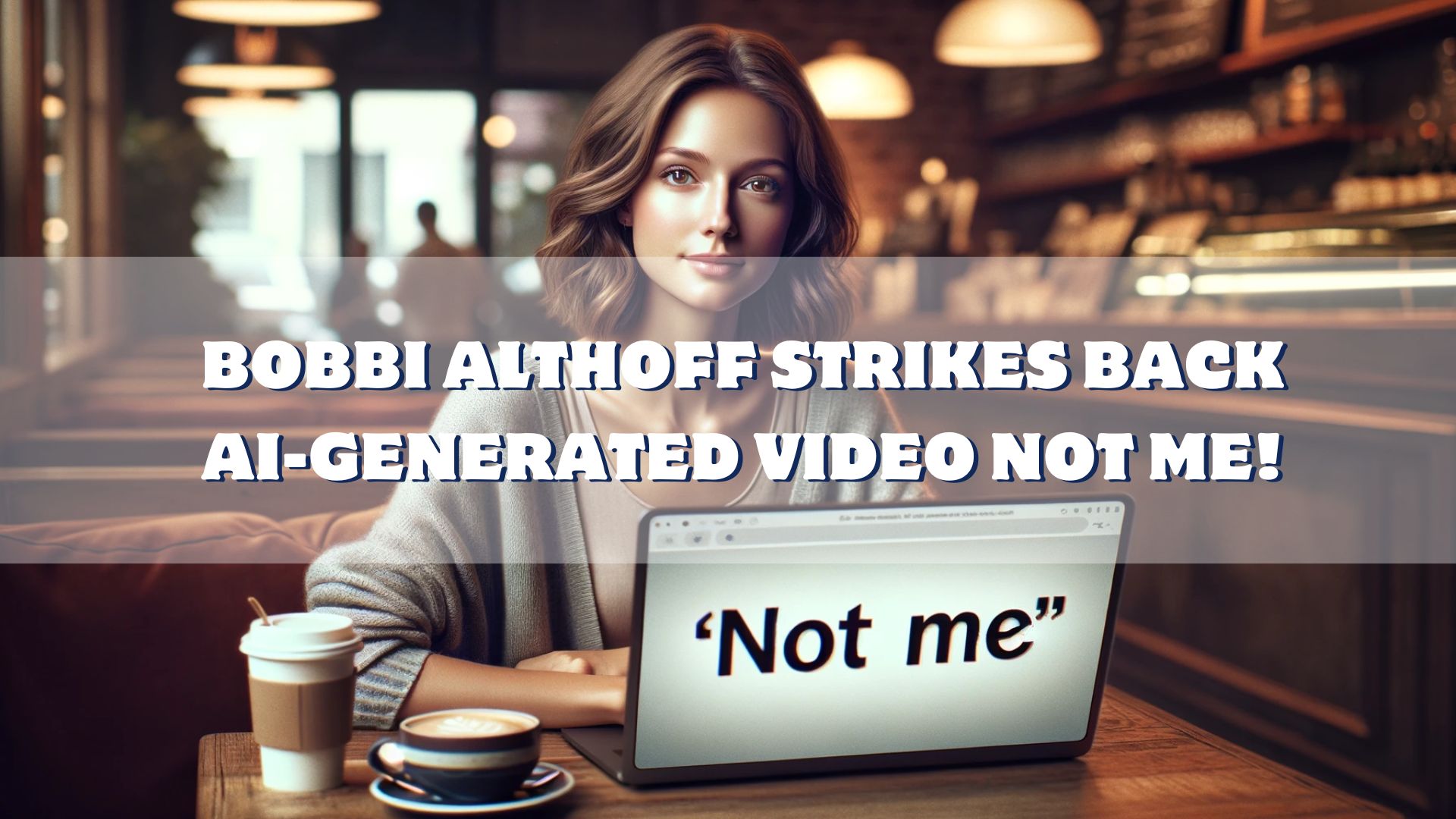
In an era where digital content can be as deceptive as it is creative, the recent controversy surrounding Bobbi Althoff, a renowned podcaster and influencer, serves as a stark reminder of the double-edged sword that is artificial intelligence. This article delves into the intricacies of the AI-generated video that falsely depicted Althoff in a compromising situation, her vehement response, and the broader implications of such deepfake content.
Bobbi Althoff’s ordeal with an AI-generated video serves as a stark reminder of the ethical and legal challenges posed by deepfake technology. Her response and the ensuing discourse highlight the urgent need for a balanced approach to digital content authenticity.
Table of Contents
What is Bobbi Althoff AI Video?
In the whirlwind of digital content that floods our screens daily, a particularly disturbing piece emerged, featuring Bobbi Althoff, a well-known podcaster and social media influencer. This video, which quickly captured the public’s attention, depicted Althoff in a highly explicit manner. However, the truth behind this video was as shocking as its content—it was not real. Crafted using advanced artificial intelligence, this deepfake video superimposed Althoff’s likeness onto another individual, creating a convincing yet entirely fabricated scenario. The technology behind such creations has grown increasingly sophisticated, allowing for the manipulation of video content with alarming precision, raising significant concerns about privacy, consent, and the very nature of truth in the digital age.
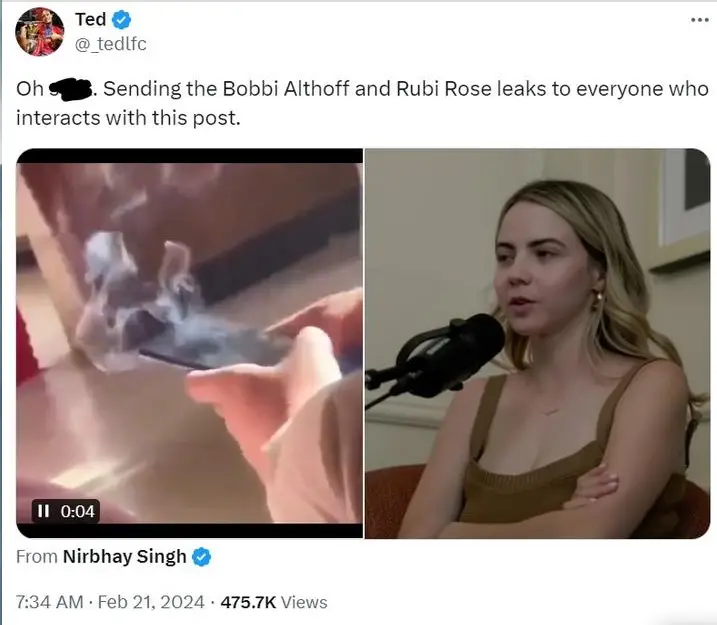
How Did the Video Go Viral?
The rapid spread of the Althoff video can be attributed to a combination of factors inherent to the nature of viral content and the sensationalism surrounding deepfake technology. Initially shared on social media platforms, the video’s explicit nature and the use of Althoff’s recognizable image made it a hot topic of discussion. The intrigue was further fueled by the underlying technology—AI-generated deepfakes, which, despite their potential for harm, have a certain allure due to their technical sophistication and the novelty factor. As shares and comments multiplied, the video transcended its original context, propelled by algorithms that prioritize high-engagement content, thus reaching a wider audience and sparking debates about the ethical implications of such realistic digital fabrications.
Bobbi Althoff's Response to the Controversy
Faced with a digital doppelgänger in a compromising situation, Bobbi Althoff took to her platforms to address the controversy head-on. With a mix of dismay and resolve, she clarified that the video was a deepfake, a stark reminder of the vulnerabilities individuals face in the digital realm. Althoff’s response was multifaceted—she condemned the creation and distribution of the video, highlighted the dangers of deepfake technology, and called for a collective reevaluation of our engagement with digital content. Her stance was not just a personal rebuttal but a public stand against the misuse of AI, advocating for more stringent regulations and ethical standards in digital content creation. Through her response, Althoff transformed a personal violation into a broader conversation about digital ethics, privacy, and the need for critical media literacy in an era where seeing is no longer believing.
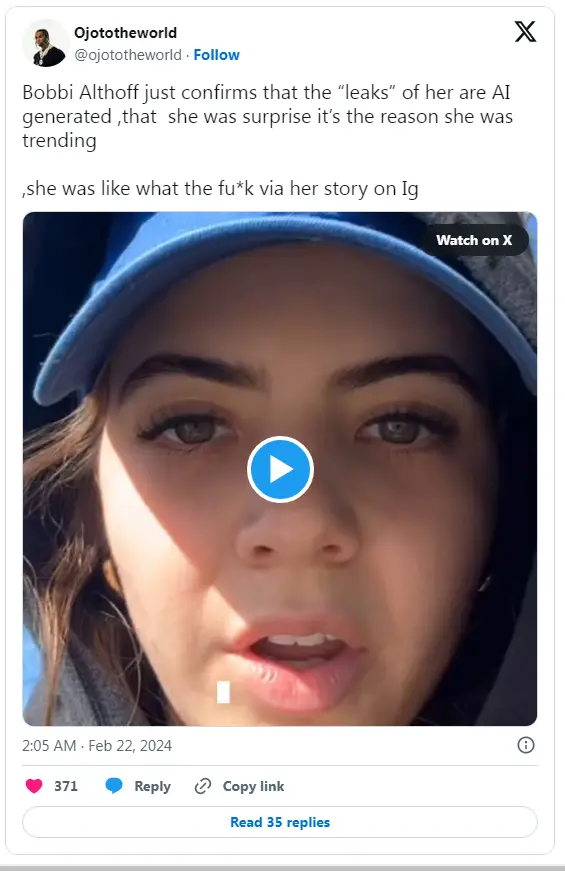
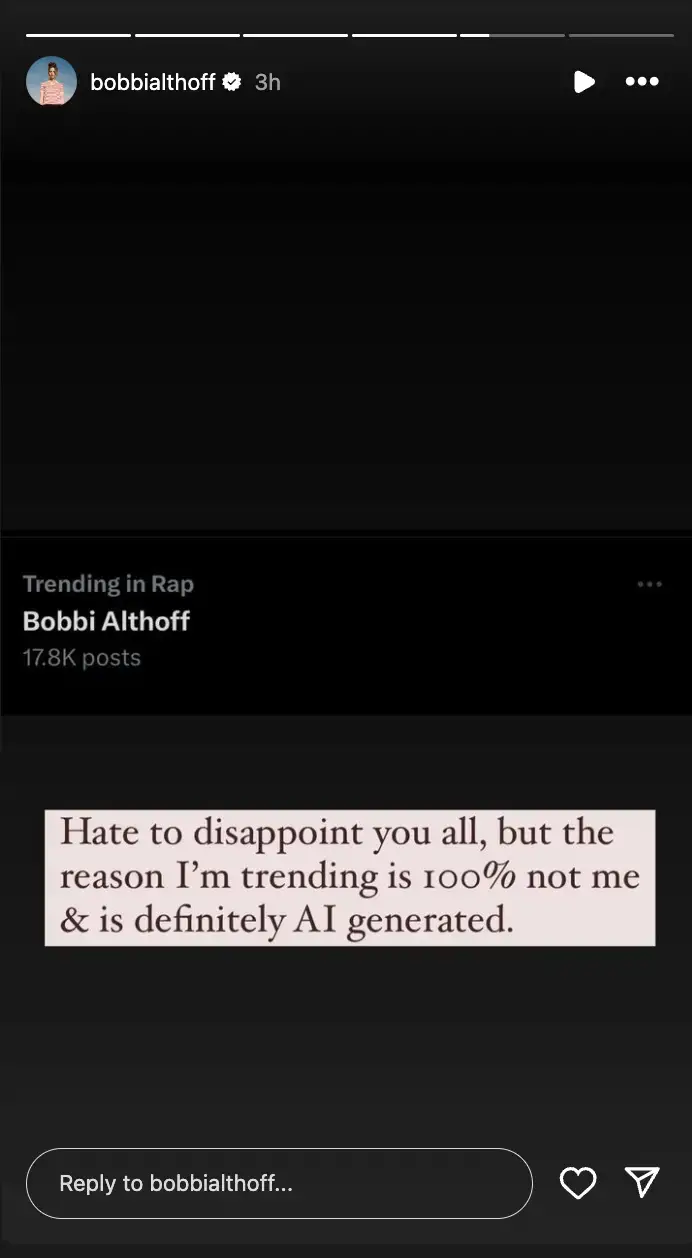


Is It Illegal To Post Others’s AI-Generated Videos On Social Media
Navigating the legal landscape of AI-generated videos involves a complex web of privacy laws, copyright regulations, and emerging legislation specifically targeting deepfake technology. The legality of posting such content varies significantly across jurisdictions, with some countries and states enacting laws that directly address the non-consensual creation and distribution of digital content. These laws often hinge on the concepts of consent, defamation, and the right to privacy, making the unauthorized posting of AI-generated videos of others a potentially illegal act. However, the rapid advancement of technology and the borderless nature of the internet present significant challenges to enforcement, highlighting the need for a global consensus on digital ethics and legal standards.
How To Identify AI Deepfake Videos?
Unnatural Facial Expressions
One of the telltale signs of a deepfake video is the presence of unnatural or inconsistent facial expressions. AI-generated content may struggle to accurately replicate the complex movements of human facial muscles, leading to anomalies that can range from subtle to glaringly obvious.
Inconsistent Lighting and Shadows
AI-generated videos often falter in maintaining consistent lighting and shadow effects across the scene. Discrepancies in how light interacts with the digitally imposed face compared to the rest of the environment can be a clear indicator of manipulation.
Audio-Visual Mismatch
In deepfake videos, there can be a noticeable lack of synchronization between the visual elements and the audio track. The voice may not match the lip movements perfectly, or the tone and quality of the audio may seem out of place, suggesting tampering.
Unusual Skin Texture
AI algorithms can sometimes struggle to replicate the natural textures and nuances of human skin. This can result in areas of the face appearing too smooth, waxy, or homogeneous, devoid of the usual imperfections and variations found in real skin.
What Did Bobbi Althoff Do to Debunk the Video?
Public Denouncement
Bobbi Althoff took immediate action by publicly denouncing the video as a deepfake. She utilized her social media platforms to clarify that the video was artificially generated, distancing herself from the actions depicted in the contentious content.
Engaging Experts
To further validate her claims, Althoff engaged digital forensic experts who specialize in analyzing multimedia content for signs of manipulation. These experts can examine the technical aspects of a video to identify inconsistencies indicative of AI-generated alterations.
Raising Awareness
Beyond addressing the video itself, Althoff took the opportunity to raise awareness about the ethical and societal implications of deepfake technology. She initiated discussions on the need for digital literacy and the importance of critically assessing online content.
Advocating for Legal Action
Recognizing the potential for harm, Althoff advocated for stronger legal measures against the creation and distribution of non-consensual deepfake content. Her stance has contributed to the ongoing dialogue surrounding digital rights and the need for protective legislation.
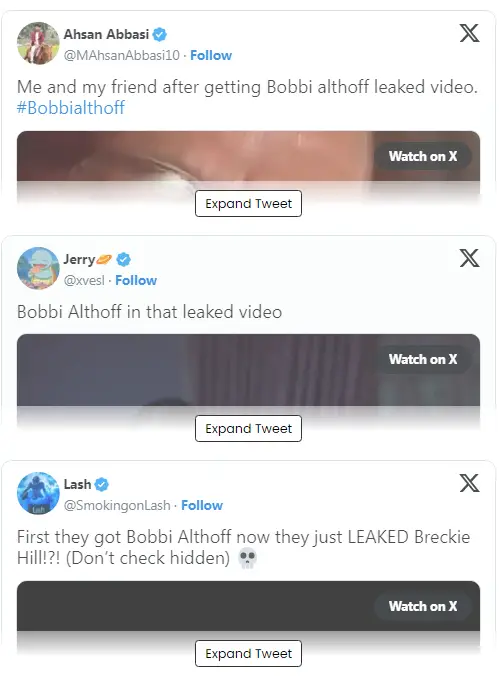
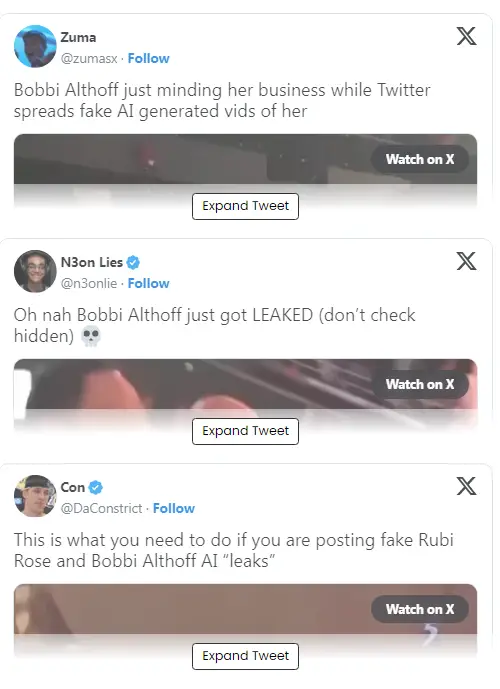
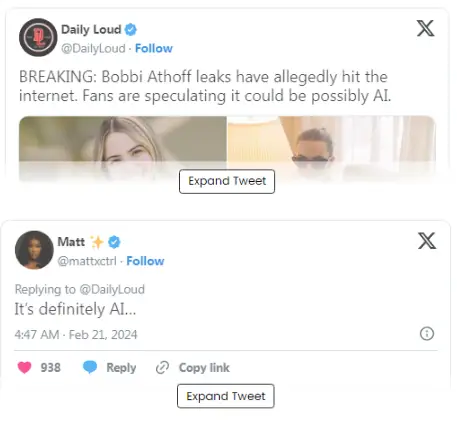

Popular NSFW AI Tools
In the rapidly evolving landscape of artificial intelligence, a new genre of NSFW AI tools has emerged, pushing the boundaries of digital content creation. Among these, Muah AI, Candy AI, Pephop, and DreamGF stand out for their ability to generate hyper-realistic, often explicit content, raising both fascination and concern.
- Muah AI specializes in creating personalized, interactive experiences, blurring the lines between virtual and reality. Its advanced algorithms can simulate scenarios that are indistinguishable from real-life interactions, catering to a niche market seeking bespoke digital encounters.
- Candy AI takes image and video manipulation to new heights, offering tools that can alter existing content or create new visuals from scratch. Its capabilities extend to modifying facial expressions, body movements, and even integrating individuals into entirely fictional settings.
- Pephop and DreamGF are known for their user-friendly interfaces, allowing even those with minimal technical expertise to create complex deepfake content. These platforms provide templates and customizable options, making it easy for users to craft content that meets their specific desires or fantasies.
While these tools showcase the innovative potential of AI, they also underscore the urgent need for ethical considerations and regulatory oversight in the realm of digital content creation.
Legal and Ethical Implications of Deepfake Videos
The advent of deepfake technology, particularly within the NSFW sphere, has ushered in a host of legal and ethical challenges. Legally, the creation and distribution of deepfake content tread a fine line between freedom of expression and violation of individual rights. Issues such as consent, copyright infringement, and defamation are at the forefront, with existing laws often ill-equipped to address the nuanced complexities introduced by AI.
Ethically, the use of deepfake technology to create explicit content without explicit consent raises significant concerns about privacy, autonomy, and the potential for psychological harm. The ability to manipulate someone’s likeness and insert it into compromising or harmful scenarios without their permission not only infringes on their privacy but can also lead to lasting damage to their reputation and mental well-being.
As society grapples with these implications, the call for updated legislation, ethical guidelines, and public education on the responsible use of AI technology becomes increasingly pressing.
Future of AI and Digital Content Authenticity
The future trajectory of AI and digital content authenticity is poised at a critical crossroads. On the horizon, there is the potential for AI to revolutionize content creation, offering new avenues for artistic expression and communication. However, this potential comes with the caveat of ensuring the authenticity and integrity of digital content.
Emerging technologies such as blockchain and advanced digital watermarking present promising solutions for verifying the origin and authenticity of digital content. These technologies can provide immutable records of content creation, modification, and distribution, offering a transparent trail that can help distinguish genuine content from manipulated or fabricated material.
Moreover, fostering a culture of ethical AI use, underpinned by comprehensive legal frameworks and widespread digital literacy, will be paramount. As we advance into this new era, the collective effort to balance the innovative potential of AI with the imperative to protect individual rights and maintain the integrity of digital content will shape the future of our digital society.

